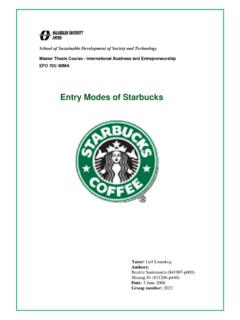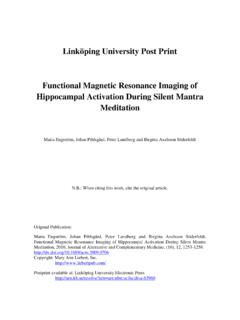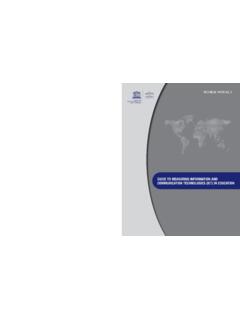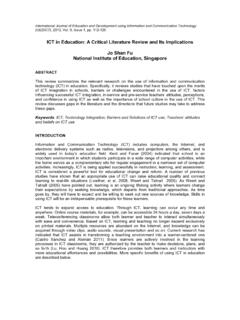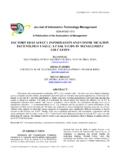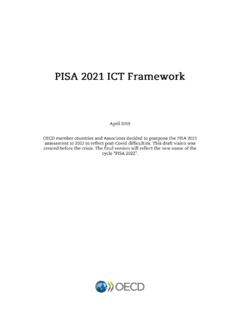Transcription of A study of the impact of technology in early education
1 UPTEC IT 14 009. Examensarbete 30 hp Juni 2014. A study of the impact of technology in early education Rafal Wajszczyk Abstract A study of the impact of technology in early education Rafal Wajszczyk Teknisk- naturvetenskaplig fakultet UTH-enheten The purpose of this study is to analyse the current state of the use of Information and communication technology (ICT) and its impact on pupils in their early stages of Bes ksadress: education . The aim is to find out how, when and in what context ICT is used in the ngstr mlaboratoriet L gerhyddsv gen 1 work with students. The overall objective is to study teachers views on ICT and their Hus 4, Plan 0 opinion on how ICT does affects pupils - positively or negatively. The results of this study are based on both a literature review and a qualitative study . The use of the Postadress: qualitative methods in-depth interviews and surveys in strategically chosen primary Box 536.
2 751 21 Uppsala schools extended the understanding and knowledge of the current state of ict in early education . The result of this study shows a number of different aspects and Telefon: issues that introduction of ict into early education has caused and how it influences 018 471 30 03 both teachers and students. As a result of the interviews and the survey answers, the Telefax: main factors that have to the highest degree influence on how ICT does affects pupils 018 471 30 00 are the access to technology and the abilities of both students and teachers. Despite all negative effects that ICT may be associated with, it can be concluded that the Hemsida: impact of ict on students is positive in most cases. Handledare: Lars- ke Nord n mnesgranskare: Mats Daniels Examinator: Lars- ke Nord n ISSN: 1401-5749, UPTEC IT 14 009. Tryckt av: Reprocentralen ITC. Contents Contents i List of Figures iii 1 Introduction 1.
3 Background .. 2. Purpose .. 3. Methods .. 4. Thesis disposition .. 4. 2 Literature study 5. ICT in education .. 5. Access .. 11. The teacher's role .. 15. The teacher's didactic choice and teaching methods .. 16. The teacher competence .. 19. 3 Theoretical perspective 23. Developmental state of children's progress .. 23. Socio-Cultural Perspective .. 26. 4 Method 29. Research strategy .. 29. Selection of respondents .. 30. Data collection method .. 30. Interview .. 30. Survey .. 31. Validity and reliability .. 32. Ethical aspects .. 33. Material processing .. 33. 5 Analysis 35. What perceptions do teachers have of ict in education ? .. 35. Access .. 35. Ability and further training .. 38. Attitude towards ICT .. 39. Changes caused by ICT .. 39. What perceptions do teachers have on how ICT influences students.. 41. i Contents ii Access .. 41. Ability .. 43.
4 ICT influence on students .. 44. 6 Discussion 51. Further research .. 53. 7 Conclusion 55. A The effects of ict in education 57. B Interview questions 60. C Survey questions 62. Bibliography 64. List of Figures Delivery of ict learning objectives as recommended by central steering documents in primary and general secondary education , 2009/10 [16].. 7. Achievement effect sizes for six types of computer-based applications, cal- culated from evaluation studies published before 1990 [25].. 8. Empirical results of educational effects of ict use as a result of FY2006. MEXT commissioned project Research contributing to promote ICT uti- lization for education . (number of students who were tested: 2,915) [27].. 9. Recommendations/suggestions on the location of ict equipment in schools in primary and general secondary education , 2009/10 [16].. 12. The percentage of teachers in Sweden who have access to a computer at work, either personal or shared with colleagues [35].
5 13. The percentage of teachers in Sweden who use computers during classes in daily bases [35].. 13. Diagram represents the percentage of how often teachers in Sweden have access to computers during classes [35].. 14. The percentage of schools in Sweden that have access to various IT tools [35].. 14. Three models of teacher's role in ICT-based educational environment [38]. 16. Different areas of concerns about children's safety and health as identified in literature [13].. 19. Types of teachers teaching ICT in primary education , 2009/10 [16].. 20. The percentage of primary school teachers in Sweden who have been trained and teachers that indicates a fairly or very high need of addi- tional training in IT-related areas [35].. 22. Answers to the survey's question: What forms of ict do you use? .. 36. Answers to the survey's question: How do you use ICT as a teacher?
6 37. Answers to the survey's question: How good is the access to ICT mate- rials? .. 37. Answers to the survey's question: How well do you feel you are trained for the challenges that ICT brings? .. 39. Answers to the survey's question: Has the role of the teacher changed with the introduction of technology in school? .. 40. Answers to the survey's question: Differs the students access to comput- ers between school and home? .. 41. Answers to the survey's question: Are students allowed to use their personal computers/tablets during classes? .. 42. iii List of figures iv Answers to the survey's question: May the students use the computers etc. only with a teacher's supervision? .. 43. Answers to the survey's question: How do you assess the students' com- puter skills? .. 44. Answers to the survey's question: What is the extend of the use of ict . in the students' school lives?
7 44. Answers to the survey's question: How often do the students use com- puters in their school work? .. 45. Answers to the survey's question: What kind of influence has ICT on the student's motivation and focus? .. 46. Answers to the survey's question: How do you see the impact of ict on the students' learning? .. 47. Answers to the survey's question: How would you rate the access to technical support? .. 48. Answers to the survey's question: Does ICT affects the student's aca- demic performance? .. 49. Answers to the survey's question: Does technology help the students to become more communicative? .. 49. study features and effect sizes in 7 evaluation reports on integrated learn- ing systems in mathematics. [25] .. 57. study features and effect sizes in 9 evaluation reports on integrated learn- ing systems in mathematics and reading. [25] .. 57. study features and effect sizes in 12 evaluation reports on Writing to Read.
8 [25] .. 58. study features and effect sizes in 6 evaluation reports on the Accelerated Reader reading management program. [25] .. 58. study features and effect sizes in 10 reports on word processing and com- puter enrichment effects on student writing. [25] .. 59. Chapter 1. Introduction One of the tasks of the modern school is to prepare students for life in the information society. Teachers should create an environment for students to acquire the ability to search, organize and use information from various sources and learn how to use informa- tion technology (IT) in a creative and productive way. This can be achieved by preparing students to use computers and IT as well as by using technology in the classroom with a variety of subjects, at all stages of education . The implementation of this task is a large and long-term project. education , like every sphere of human activity in society, undergoes evolution associ- ated with changes in the conditions in which it is conducted.
9 The direction of these modifications are determined by the educational concepts or are natural result of the transformations of the social and technical measures that accompany education . The education system reorganize its settings of the program curriculum and school activities dictated by the central authorities, schools and teachers and slowly evolve into a system that supports individual educational goals of students. The Swedish National Agency for education , Skolverket, has a specified curriculum for the compulsory schools, preschool and the recreation centre in which the following statement can be found: Teaching should be adapted to each pupil's circumstances and needs. It should promote the pupils' further learning and acquisition of knowledge based on pupils' backgrounds, earlier experience, language and knowledge. [1]. The school shall, above all, help students in developing their own education .
10 The use of modern IT in education is an opportunity to emerge a cognitive resource-based mech- anism in students and develop the skills and the importance of lifelong learning and continuous education . It can also facilitate a more individual approach and individual- ized communication between teachers and students. 1. Chapter 1. Introduction 2. As mentioned before the school should prepare for a life in the modern world, which is difficult to imagine without computers and the skills to use them. Changes in the educa- tion system should therefore take into account the changes that are taking place around us in society. One of the most important factors, which already has a huge impact on individuals, communities and entire societies is IT, which increases the possibility of active participation of citizens in the functioning of their communities. The national curriculum created by Skolverket acknowledge the importance of technology and re- quires the use of IT in all sectors of education since IT has become an integral part in many fields.

